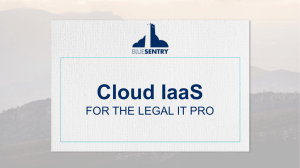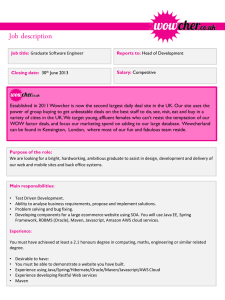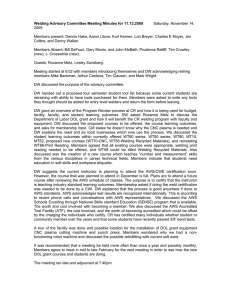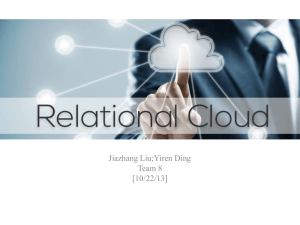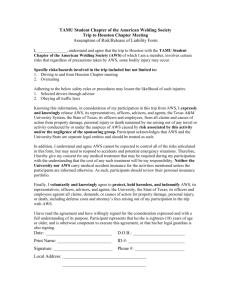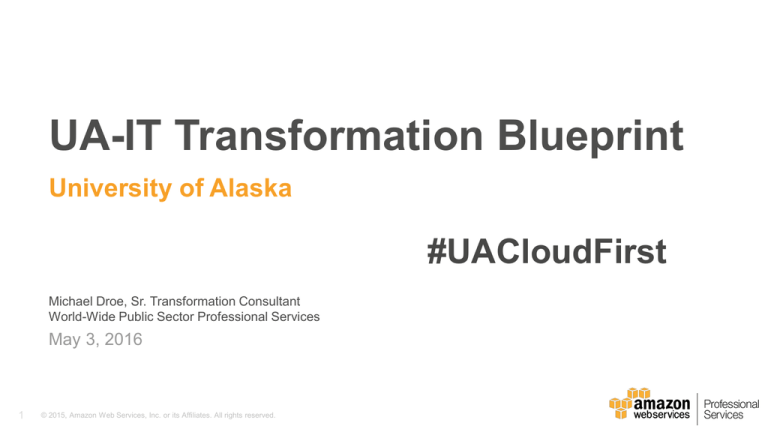
UA-IT Transformation Blueprint
University of Alaska
#UACloudFirst
Michael Droe, Sr. Transformation Consultant
World-Wide Public Sector Professional Services
May 3, 2016
1
© 2015, Amazon Web Services, Inc. or its Affiliates. All rights reserved.
Purpose
• To establish a common understanding and expectations
for the activities, project flow, time requirements, outputs
and communication elements for successful delivery of
the AWS IT Transformation Blueprint for the University of
Alaska.
• To socialize, understand and capture expected impactful
outcomes and potential blockers.
• Initiate the delivery of the UA IT Transformation Blueprint
project.
2
AWS Cloud Adoption
Framework
3
AWS Cloud Adoption Journey
Business Impact?
What to measure?
How to measure?
What are the
priorities?
When to deliver
solutions?
How to design
foundations?
How to migrate
workloads?
What skills and
capabilities are
required?
How to compose
adoption team?
How to structure
cloud programs?
Strategy for quality
delivery and
operations?
What tooling do we Will risk increase?
Can we run cloud
need?
secure and
What is the new
compliant?
ITSM cycle?
4
Customers are asking us for the
high-level enterprise-wide
organizing logic for mapping their
business needs to IT capabilities,
reflecting the agility, integration and
standardization changes that cloud
computing brought to IT industry.
Strategic relationships are openingup new set of questions, requiring
AWS to demonstrate delivery
capability, technology insight, and
practical business value to our
customers.
AWS Cloud Adoption Framework
Why?
Tracking the value, value traceability, Cost/benefit, value
dependency
How?
Service delivery model – iterative, modular, agile and
adaptable
Process Perspective
Who?
Right partners, right teams, right skills Sourcing/partnering, teaming/staffing, skills/readiness
People Perspective
When?
Measuring and balancing the maturity of P-P-T,
understanding risks
Maturity Perspective
What?
Easy-to-understand conceptual architecture, rapid
solutions composition, mapping to RAs
Platform Perspective
Where?
5
Business Perspective
Monitoring, metering and managing hybrid IT environments
Consistent SLAs, metrics, standards and policies
Operations Perspective
AWS Cloud Adoption Framework
Business
Perspective
Maturity
Perspective
People
Perspective
Operations
Perspective
6
Platform
Perspective
Process
Perspective
Security
Perspective
The AWS CAF organizes and
describes the perspectives in
planning, creating, managing, and
supporting a modern IT service.
Offers practical guidance and
comprehensive guidelines for
establishing, developing and running
AWS cloud-enabled environments.
It provides a structure where business
and IT can work together towards
common strategy and vision,
supported by modern IT automation
and process optimization.
CAF Core Perspectives
Business Perspective
Identifying, delivering, and measuring
business impact using architectural
approaches that align technical delivery to
business imperatives.
Platform Perspective
Represents the technology services of the
AWS cloud platform. Provides patterns,
guidance, and tools for optimal use of the
technology services and services to
implement.
Maturity Perspective
Defining the target state architecture of the
organization and creating the required
blueprints and roadmaps.
7
People Perspective
Defining and acquiring the skills needed to
adopt the AWS cloud platform. Examples
guidance include role descriptions, training,
certification and mentoring.
Process Perspective
Managing portfolios, programs and projects
to deliver expected business outcome on
time and within budget, while keeping risks
at acceptable levels.
Security Perspective
Defining and implementing the required
levels of security, governance, and risk
management to achieve compliance.
Operations Perspective
Represents the ongoing management of the
functioning IT environment of AWS.
Provides process, guidance and tools for
optimum operational service management of
the AWS environment.
AWS Cloud Adoption Framework
8
Why?
Value
Management
How?
Portfolio
Management
Service
Delivery
Management
Program &
Project
Management
Continuous
Integration/
Continuous
Delivery
Who?
Organizational
Structures
Roles and
Job
Descriptions
Skills
and
Competencies
When?
Cloud
Readiness
Assessment
Cloud
Maturity
Heat-map
Assessment
Target Platform
Capabilities
What?
Design
Architecture
Where?
Cloud Service
Management
IT Strategy
Risk
Management
Business Perspective
Process
Automation
Quality
Management
Process Perspective
Training
Certification
Readiness
Manage
Staffing
Organizational
Change
Management
People Perspective
Application
Portfolio
Analysis
Roadmap
sequencing
IT Management
Assessment
Maturity Perspective
Architecture
Optimization
Platform Perspective
Performance
&
Operational
Health
Operations Perspective
Cost
Management
Portfolio
Governance
Implementation
Architecture
SLA/OLA
Strategy
Business
Continuity
Planning
Incident &
Problem
Mgmt
Change and
Configuration
Management
AWS Cloud Adoption Framework
Last but not least…
Assured?
9
Security
Strategy
Security
Reference
Architecture
Governance,
Risk &
Compliance
Lifecycle
Security
Capabilities
DevSecOps
Principles
Security
Operations
Playbook
Security Perspective
The Cloud Adoption Framework Journey
Understand
Business
Strategy
10
Rapid Discovery
Explore
AWS CAF
Perspectives
Delivery Phases
AWS Cloud Adoption Framework
A consolidated view of a comprehensive framework that helps bring together people, process, and
technology to drive efficient, effective, and secure cloud adoption, based on defined business objectives
Business & Cloud Strategy
Innovate and Transform
11
Rapid Discovery & Planning
Baseline
Gap
Activities
People
Process
Improve
Platform
Operations
Run
Migrate
Perspectives
Business
Iterate & Continuous Improvement
AWS
Partner/s
Security
Maturity
Report.
Measure
Building the Adoption Roadmap
Identify Cloud
Expectations, AsIs/To-Be states and
gaps into key
findings.
Agile/SCRUM
Methods
12
Analyze and
breakdown the
cloud expectations /
key findings /
challenge issues
into core
dimensions
(People x Process
x Technology x
Funding)
Align each issue to
known strategic
priorities
Identify and study
supporting
Components of the
AWS Cloud
Adoption
Framework that
address the
identified issues
Epics &
Stories
Perform a
Discovery
Workshop / Cloud
Readiness
Assessment
(GRC/Technology
&
Architecture/People
& IT Management)
Sequence the CAF
Components into a
high-level CAF
Roadmap to
appropriately and
realistically scaffold
knowledge and
capabilities
Identify and
prioritize
appropriate
activities for the
sequenced CAF
Component to
address gaps in the
readiness
assessment
Backlog
Assign activities to
the appropriate
3C/CCoE
Perspective leads
using a common
project/program
framework.
Execute, regularly
report status
(transparency) and
celebrate wins
Building the Adoption Roadmap
Org
Structure
Cost Mgmt
Capability
Review
Security
Review
Architecture
Optimization
Process
Automation
BCP
13
Large Adoption Roadmap - Example
Common
Understnding
14
Benefits
Cloud
Discovery
People &
Governance
Architecture &
Migration
Operations &
Optimization
But wait, there’s more…
15
AWS IT Transformation
Process
16
Transformation Process
Developing and implementing a cloud journey that is…
Systemic
Supportable
Sustainable
17
Transformation Process – An Overview
1. Establish Common Understanding
Observations:
Cloud Adoption requires an organization to take on a new method
of providing IT services and involves change at many different
levels.
Successful transformations require strong executive sponsorship
early in the process, and a commitment from the organization.
Proper planning and communication of the process are vital parts
of the process.
It is important to determine the overall benefits to the
organization, provide training for staff, develop the foundational
architecture, assess the environment , and develop security
controls part of the overall transformation.
4. Complete Enterprise Agreements
An Enterprise Agreement (EA) can be completed
between AWS and the organization to ensure that
the appropriate contracting provisions exist.
Enterprise organizations can either sign a unilateral
or bilateral Non-Disclosure Agreement (NDA) with
AWS.
An Implementation Services Addendum (ISA) is
attached to the enterprise agreement for
contracting with AWS Training or Professional
Services (ProServe).
A Business Associate Agreement (BAA) is used to
protect personal health information (PHI) with
HIPAA guidelines.
7. Application Migration
Application Portfolio Assessment
A detailed assessment of all workloads is essential for understanding resources,
dependencies, licensing, etc.
Assessed workloads can be placed into phases for migration based on pre-determined
patterns and dependencies.
Migration Factory
Migration Factory refers to the group(s) designated to assist in the planning and
migration of in-scope workloads to AWS.
The factory includes processes, procedures and tools.
Amazon Partner Network (APN) partners are uniquely skilled at migrating workloads
in the most effective and efficient manner possible.
2. Identify Benefits to the Organization
Total Value of Ownership
Understand the value of AWS for the organization in terms of
agility, availability, disaster recovery, cost and reach.
A high-level value analysis will align with the objectives and
support the mission of the organization.
Cost-Benefit Analysis
AWS provides a Total Cost of Ownership (TCO) analysis that helps
organizations develop the business case for adopting cloud
services
The transformation requires a move from CapEx to OpEx and
allows organizations to only pay for what they utilize
Reallocation of Resources
Optimal cloud adoption requires a plan to refocus IT resources to
meet customer demand, align to organizational objectives and
support business strategy.
3. Build Knowledge and Capacity
Training and Documentation
AWS provides different levels of support and training for customers
ranging from free, self-help videos to instructor-led training. All
services include detailed documentation.
AWS Self-Paced Training
Introduction to AWS videos
AWS Essentials Training
Instructor-Led Training
Architecting on AWS
Architecting on AWS – Advanced Concepts
Developing on AWS
Systems Operations on AWS
Advanced Operations on AWS
Specialty Training
Big Data Technology Fundamentals
Big Data on AWS
5. Conduct Enterprise Maturity Assessment
The maturity
of key IT service
management
processes are
assessed to
ensure that the
cloud transformation is sustainable, supportable
and systemic.
Detailed design of security controls and processes
Best-practices design of the virtual private cloud
(VPC) environment
Establishment of network connectivity and
integration
Architecting for high-availability and disaster
recovery
Development of application patterns for the
migration of current state workloads to AWS
Decoupling of enterprise-class workloads for
migration to AWS
6. Design Cloud Infrastructure
8. Institute Cloud Operating Model
AWS provides services to help organizations move to a continuous integration /
continuous delivery model to increase agility.
AWS includes integrated tools such as OpsWorks, Trusted Advisor (below), CloudTrail
and CloudWatch that help measure, track, monitor, alarm and operate the cloud
environments in an optimal manner to drive continuous improvement.
There are many 3rd
party tools that are
specifically developed
to help operate your
AWS cloud in the most
efficient way possible.
18
Version 1.0 (01/15/2015)
Transformation Process
1. Creating a common foundation…
19
Cloud Strategy Vision
20
Managing Assets
Managing Access
•
•
•
•
•
•
•
•
•
•
•
•
•
•
Lifecycle Model (CAPEX+OPEX budgeting)
Boxed-based provisioning / Exponential DR
Operational accountability
Linear support demand
Capacity first
Engineering focus
Fragmented security policy
Utility Model (OPEX budgeting)
Code-based provisioning/ linear DR
Functional accountability
y = tan-1 x (x > 0) support model
Service first
Integration focus
Centralized security policy
Governance Team Modeling
Strategy
Platform
Business
Perspective Perspective
Architecture
DevOps
Security
PMO
Support
Attributes
•
•
•
•
•
People
Maturity
Process
Perspective
Perspective
Perspective
CCC/CCoE
Engineering
Operations
Perspective
Security
Perspective
Scalable teaming model – based on 2-pizza team
Roles and accountabilities for complete ITSM (owning the service)
Well-rounded universalists for cloud computing era
Skills profiles for various roles in the team
Balancing development, sysops, project management and business
capabilities
• Each member assigned “ownership” of a CAF perspective
21
Transformation Process
Creating a common foundation…
• Cloud Adoption requires an organization to take on a new method of
providing IT services and involves change at many different levels.
• Successful transformations require strong executive sponsorship
early in the process, and a commitment from the organization.
• Proper planning and communication of the process are vital parts of
the process.
• Creation of an active core team or center of excellence aligned to
the CAF Perspectives promotes collaboration, sustains alignment
and reduces overall risk for subsequent efforts:
•
22
Determining overall benefits to the organization; providing aligned training for
staff; developing the foundational architecture; assessing the environment;
and developing security controls aligned with policy.
Transformation Process
2. Identifying the benefits…
23
Identifying benefits…
AWS TCO Calculator
24
AWS Simple Monthly Calculator
Transformation Process
Identifying benefits…
Total Cost of Operation (TCO)
• AWS provides a Total Cost of Operation (TCO) calculator that helps organizations
develop the business case for adopting cloud services
• The transformation requires a move from CapEx to OpEx and allows organizations to
only pay for what they utilize
Total Value of Operation (TVO)
• Understand the value in terms of agility, availability, disaster recovery, cost and
reach.
• A high-level value analysis will align with the objectives and support the mission of
the organization.
Reallocation of Resources
• Optimal cloud adoption facilitates a refocus of IT resources to meet customer
demand, align to organizational objectives and support business strategy.
25
Transformation Process
3. Creating teams, aligning skillsets & training…
26
Transformation Process
Creating teams, aligning skillsets & training…
• Provide foundational knowledge
AWS provides different levels of support and training ranging from on-line documentation to free,
self-help videos and self-paced labs to instructor-led training.
• AWS Self-Paced Training
•
•
•
Instructor-Led Training
•
•
•
•
Introduction to AWS videos
AWS Essentials Training
Architecting on AWS & Architecting on AWS-Advanced Concepts
Developing on AWS
Systems Operations on AWS & Advanced Operations on AWS
Specialty Training
•
•
Big Data Technology Fundamentals
Big Data on AWS
• Following a training plan aligned roles that address gaps in the migration process
and the future state cloud operating model.
27
RACI Matrix and Training Plan (Example)
28
28
Transformation Process
4. Addressing contractual needs…
29
Transformation Process
5. Discovering & assessing the environment…
30
Transformation Process
Discovering & assessing the environment (readiness)…
Several dynamics of the IT environment must be discovered/assessed to
understand maturity and readiness for transformation that is sustainable,
supportable and systemic. This may include:
•
•
•
•
•
31
Governance, standards & policies
Knowledge & skills
Key service management processes
Infrastructure & common/shared services
Security & compliance controls
Transformation Process
6. Design Cloud Infrastructure…
32
Transformation Process
Design the Supporting Cloud Infrastructure…
•Detailed design of security controls and processes
•Best-practices design of the (multi-) virtual private cloud (VPC) environment
•Network connectivity and integration
•High-availability and disaster recovery
33
Infrastructure
& Migration
Preparation
Infrastructure
Migration
Week 1
Week 2
Diagram Account , VPC Structure & Network
Identify SSO & Key Management Processes
Determine Security Variances
Identify Environment Exceptions, Integrations & Partners
Validate VPC Infrastructure
Determine Environment Exceptions & Integrations
Identify Necessary Roles/Credentials
Implement Account Structure
Implement IDM/SSO & Account Federation
Implement VPC & Security Groups
Configure Admin/Security Logging & Alerting
Implement Exceptions & Integrations
Validate AWS Monitoring & Alerting
Validate Integrations
Determine Migration Processes
Key
34
Discover
Design
Engage Authorization Process
Build
IA Sign-Off
Create CF Template
Transformation Process
7. Application Migration…
35
Sourcing Values and Input Methodology
Organizational applications are classified in accordance with several sourcing criteria provided as part
of the portfolio analysis and subsequently validated by application stakeholders. The criteria and
narrative describing the assigned values are provided below. Note that in most cases, a composite of
multiple values from the inventory is used to arrive at a single classification value.
Assessment Criterion
Level of Differentiation to
Organizational
Complexity of Operation
Skills and competencies
36
Input
Classification Justification
(1-Low / 3-High )
Weight
- Impact on achieving the mission
1 – Non differentiator
2 – Low differentiator
3 – Core differentiator
60%
- Number and complexity of business
rules/processes
1 – Low complexity of operation
2 – Moderate complexity of operation
3 – High complexity of operation
20%
1 – Highly specialized skills that are a challenge to
hire and retain
2 – Moderate specialized IT/product skills
3 – Common IT/Admin/Programming skills
20%
- Specialized skills required to support and
operate
36
Hosting Values and Input Methodologyand
Input Methodology
Organizational applications are classified in accordance with several hosting criteria provided as part
of the portfolio analysis and subsequently validated by application stakeholders. The criteria and
narrative describing the assigned values are provided below. As with Sourcing, a composite of multiple
values from the inventory is used to arrive at a single classification value.
37
Assessment Criterion
Input
Classification Justification (1-High fit / 5-Low fit)
Technical Architecture
- Architecture Styles
- Technical Complexity
- Application Hosting
1 – Cloud developed, three tier web applications with Amazon AMIs existing.
2 - Somewhat complex; tech environment is still relatively stable but the integration points with other
applications are complex. Core application though is web capable.
3 - Highly complex, not cloud, not web, or new to Organizational.
Commodity vs Specialty
- # of products/services supporting
the capability
- # of customers for the capability
1 - Large number of products/services with large number of customer across multiple segments
2 – Small group of niche products/services with a small number of customers across one or a small
number of segments
3 – Unique to Organizational with no existing products/services available to deliver the capability
Risk
- Technical Risk Score
- Technical Risk Summary
- Technical Alignment
- Sensitive Data
1 – Low Risk, non strategic application
2 – Medium Risk, strategic or business application internally facing or with small exposure
3 – High Risk, Strategic, externally facing, mission critical application, Sensitive Data
37
Migration Planning
Sourcing Model
The sourcing model depicts the relationships between the various Sourcing and Hosting options that are combined to
deliver Acme capabilities.
Capabilities
Sourcing Evaluation
Who should manage
the business
operations?
Partner
Managed
Organizationa
l Services and
Applications
Who should manage the
technical operations
supporting Organizational
services?
Hosting Evaluation
How should the the
solution components be
realized?
Product
Partner
Managed
SaaS / PaaS
Product
ITS
Managed
PaaS
Integration
Amazon RDS
Amazon
Route53
Amazon ELB
IaaS
Integration
Amazon EC2
Amazon S3
Amazon VPC
Organization
al Managed
Data Center
Managed
Data Center
Infrastructure
Sourcing Decisions
38
Acquia
Appian
Remedy OnDemand
HPC
Mainframes
Hosting Decisions
38
Migration Planning
Application Portfolio Analysis
Application Index:
01
02
03
04
39
OFM Dashboards
DevHelper
CRRS
OFMS
05
06
07
08
Sample.org
Orchestrator
FAS
WFmgr
09
10
11
12
IAMS
Identity Manager
iSuggestions
KnowledgeDocs
13
14
15
16
Remedy
SSO
TeamHelper
TeamTicket
39
Migration Planning
Application Portfolio Assessment
Public Web Services
Application ID#
Name
Description
Not Available
Sample.org
Organizational public web server and content management system
Analysis Breakdown
Level of
Differentiation
Complexity of
Operation
Skills and
Competencies
Technical
Architecture
Commodity vs Specialty
Risk
Composite Classification
3
1
3
1
1
3
MSP Managed - PaaS
Recommendation
There are many valid options available for a web hosting capability. Self-hosting on premise has many challenges in the areas of scalability, availability
and resource utilization, due to lack of the necessary infrastructure. Also, fully administering the web hosting infrastructure adds very little differentiation
benefit to the organization. There are three options that should be considered:
1.
Migrate web sites to Acquia Cloud Enterprise PaaS
2.
Migrate the web hosting platform to a Drupal open source platform in a self-hosted AWS IaaS model
3.
Use the ITS reference architecture to migrate the workload onto a mix of AWS infrastructure and platform services
40
4
Transformation Process
Migrating the applications…
• Develop the Migration Plan
•
•
•
Develop the sourcing model
A detailed assessment of all
workloads to understand resources,
dependencies, licensing, etc.
Assessed workloads can be placed into
phases for migration based on pre-determined patterns, dependencies and optimal TCO
• Initiate a Migration Factory
•
•
•
41
Iterative (Scrum-based) planning and
migration of in-scope workloads to AWS
The factory includes processes, procedures
and tools
Leverage automation and the Amazon Partner
Network (APN) partners in the most effective
and efficient manner possible
Domain
Phase
Strategy
Initiate
Discover
Build (Move)
Design
Migrate
Integrate
Run
Validate
Operate
Optimize
Migration Factory
Continuous Migration Evaluation and Feedback
Prioritized
Migration
List
Migration
Initiation
Application
Portfolio
Discovery
50%
Automation
Services
Enablement
Baseline
Foundations
Architect Target
Environment
42
Plan
Business
Strategy &
Objective
Activities
AWS Migration Process
AWS Cloud Adoption Framework (CAF)
AWS Application Migration Methodology
App Portfolio
Assessment
Build Pipeline
Application
Analysis
Migration
Candidates
Migration
Design
Migrated
Applications
Migration
Integration
50%
Automation
Cloud Fit
Assessment
App Selection &
Prioritization
Validation
30%
Automation
Execution Plan
Process & tools
refinement
Capture
Infrastructure
Move
Apps/Infra/Data
RightSizing
AWS Resources
Application
Integration
Infrastructure
Integration
Operational
Integration
Functional
Validation
Secure ACL
BU Acceptance
Operate
Optimize
50%
Automation
50%
Automation
Monitoring
Daily
Operations
Optimization
Support
Application Migration
Week 1
Application Owner Meeting
Week 2
Document Success Criteria
Verify VPC Connectivity
Review Existing Blueprints
VPC Architecture Design
Initial Architecture Design
Application Dependencies
Update Final Design Document
Resolve Dependency Conflicts
App Architecture Review
App Owner Review
Identify Enhancement Opportunities
Identify Testing Process
Deploy AMI’s
Intra-port Requirements
Allocate Credentials
VPC Port
Exception
Verify Subnet
Connectivity
Identify Application Artifacts
Data Migration Requirements
Connectivity Requirements
Baseline Performance
Firewall Port Determination
Application Installation
Test Application
Firewall Requests
Connectivity
Migrate Data
End to End Testing
Complete Artifact Checklist
Owner Sign-off
43
Key
Discover
Design
Build
Transformation Process
8. Initiate the Cloud Operating (& Optimization) Model…
44
Transformation Process
Operation & optimization…
• AWS provides services to help organizations move to a continuous integration /
continuous delivery model to increase agility
• AWS includes integrated tools that help measure, track, monitor, alarm and
operate the cloud environments in an optimal manner to drive continuous
improvement, including:
• AWS Service Catalog
• AWS CloudTrail
• AWS OpsWorks
• Trusted Advisor
• AWS CloudFormation
• Amazon CloudWatch
• AWS CodeDeploy
• Amazon API
Gateway
• AWS Config
• AWS CodePipeline
• AWS CodeCommit
• Budgets and
Forecasts
• There are many 3rd party tools that are specifically developed to help operate
and optimize the AWS cloud in the most efficient way possible
45
Q&A
46
michdroe@amazon.com
47

